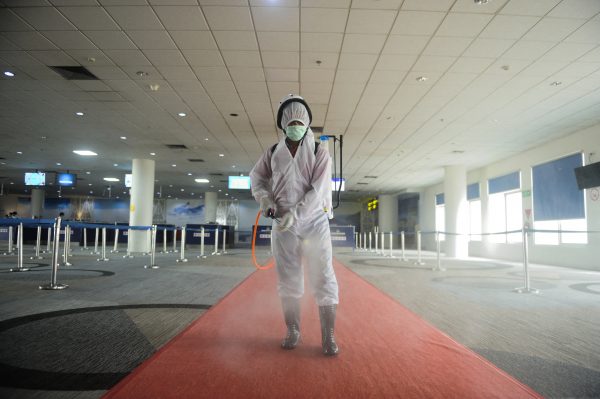As of 15 June 2020, COVID-19 has taken more than 436,000 lives, infected more than eight million people and brought about half a billion people — 8 per cent of the world’s population — into poverty, including 60–80 million into extreme poverty.
In Indonesia alone, between early March and mid-June, COVID-19 caused 2,134 deaths, infected 38,277 people and dragged more than 1.1 million into poverty. An estimated 30 million Indonesians will fall into poverty this year — worse than Indonesia’s experience after the global financial crisis.
This pandemic is affecting the Indonesian economy in three ways. First, lower global demand is reducing demand for Indonesia’s main export products. Second, as global capital dries up, foreign direct investment to Indonesia is also decreasing. A drop in tourism is also hitting services and many small and medium-sized enterprises (SMEs) hard. The Indonesian economy is estimated to grow at a maximum of just 0.5 per cent this year, and only if the Chinese economy can grow at 1.2 per cent. It will take Indonesia at least three years to recover its COVID 19-related economic losses.
To mitigate the economic impacts of COVID-19, the Indonesian government has launched a major fiscal stimulus package totalling around Rp 405.1 trillion (US$27.5 billion), equivalent to about 2.5 per cent of GDP. Of this amount, Rp 75 trillion (US$5.1 billion) is earmarked to support the healthcare sector, Rp 110 trillion (US$7.4 billion) for social safety nets, Rp 70.1 trillion (US$4.7 billion) for tax incentives and Rp 150 trillion (US$10.1 billion) for National Economic Recovery.
The fiscal stimulus package is accompanied by monetary stimulus that will reduce interest rates to 4.5 per cent, lower reserve requirements for banks and increase the maximum duration for repos and reverse repos to up to 12 months. The stimulus will also introduce daily repo auctions and increase the frequency of foreign exchange swap auctions. Bank Indonesia will take measures to ease liquidity conditions and support bond market stability.
While a combination of fiscal and monetary stimulus packages is a good start, there are many areas for improvement in its implementation.
First, the COVID-19 social safety nets must be effective and efficient, but temporary. Indonesia should learn from its past mistakes and ensure that subsidies for fuel and rice are provided at the cost of future generated income. The payment should be delivered according to a clear, single criterion — for example, the social protection payment should go to families that do not have access to electricity or who use a maximum of or less than 450 watts per month.
Second, all tax incentives should go only to productive sectors such as agriculture, industry and services. In the last 10 years, around 30 per cent of loans went to consumption goods, only 15.8 per cent went to industry and 7 per cent went to agriculture, forestry and fisheries. There is no reason for lower interest rates to go to property or consumer goods. Easing both the interest rate and the terms of the interest for productive activities will help to ‘correct’ the economy in the long run. If the government fails to achieve this, Indonesia will be trapped into providing subsidies for unused commodities.
Third, to address the issue of rising youth unemployment, the government launched ‘pre-employment cards’ on 11 April this year. This scheme provides unemployed people with access and funding for a range of training to improve their chances of finding work. The government has allocated Rp 20 trillion (US$1.3 billion) for the program, targeting 5.6 million workers who were either laid off or furloughed, including informal workers and SMEs impacted by COVID-19. Each beneficiary will receive a training fund worth Rp 1 million (US$67), post-training incentives of Rp 600,000 (US$40) a month for four months and an incentive of Rp 150,000 (US$10) for completing three surveys on their working status.
The program was received with great enthusiasm — 1.4 million people applied for it on the first day.
Despite good intentions in offering a multi-benefit program that provides financial support as well improving skills and productivity, the pre-employment card has at least three main caveats that need to be addressed.
First, this program has been criticised because a large chunk of the funds goes to services providers for materials that were already readily and publicly available. This will not solve the core problem of the laid-off and furloughed workers, who urgently need ‘cash to survive’ while they wait for employment opportunities to arise.
Second, the program lacks transparency in how training services providers are selected and how their credibility to share skills and education is determined.
Lastly, there are issues with the data on beneficiaries. The government should have a clear database of targeted beneficiaries. But, in a recent interview, a senior official mentioned that applicants can be rejected if they include low-quality pictures in their application. If the government is not well-prepared, there is a risk that the program will not be rolled out fairly and well-distributed.
The bottom line is that the stimulus package and pre-employment card program should be accompanied by a well-prepared list of targeted beneficiaries and a well-designed monitoring and evaluation system to ensure that these programs are ‘purely social and not political’.
Lili Yan Ing is Lead Advisor (Southeast Asia Region) at the Economic Research Institute for ASEAN and East Asia (ERIA), Jakarta.
Yessi Vadila is a trade analyst at the Indonesian Ministry of Trade.
This article appears in the most recent edition of East Asia Forum Quarterly, ‘Immunising Asia’, Vol. 12 No. 2.
This article is part of an EAF special feature series on the novel coronavirus crisis and its impact.

